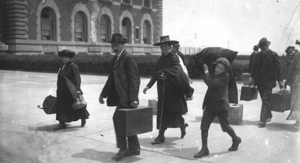 Immigration policy rose in national importance in the 1920s for a couple of reasons. “Economic concerns, nationalism brought about by World War I, and a tilt toward a smaller percentage of new immigrants with English as their native language contributed to moving public sentiment towards restricting immigration”. The emergence of “Eugenics” as a public policy tool in policy circles and Western philosophy also played a role. “Eugenics is the belief in improving the qualities of the human race by preventing the reproduction of people deemed to have genetic defects or undesirable characteristics and/or encouraging increased reproduction by those with supposed desirable inheritable characteristics.” According to Anderson, this widespread belief in eugenics was a decisive factor in creating the restrictive immigration laws in the 1920s. Natives in Canada and the United States were in favor of the status quo of their countries, so they did not want a large amount of immigrants they deemed as “undesirable” tainting their countries national structure.
Immigration policy rose in national importance in the 1920s for a couple of reasons. “Economic concerns, nationalism brought about by World War I, and a tilt toward a smaller percentage of new immigrants with English as their native language contributed to moving public sentiment towards restricting immigration”. The emergence of “Eugenics” as a public policy tool in policy circles and Western philosophy also played a role. “Eugenics is the belief in improving the qualities of the human race by preventing the reproduction of people deemed to have genetic defects or undesirable characteristics and/or encouraging increased reproduction by those with supposed desirable inheritable characteristics.” According to Anderson, this widespread belief in eugenics was a decisive factor in creating the restrictive immigration laws in the 1920s. Natives in Canada and the United States were in favor of the status quo of their countries, so they did not want a large amount of immigrants they deemed as “undesirable” tainting their countries national structure.
This word “undesirables” is funny in this context because the factors in which made a person undesirable were two different types of people: criminals and people of different races. Racism, therefore, was a major aspect in creating the immigration policy of the 1920s. The Ku Klux Klan started in 1915 to “control minority groups which it identified with moral and political nonconformity”. There was strong support for anti-Jewish sentiments. A quote from U.S. consuls abroad said that “by barring legislative action the United States would face an onslaught of Jews who were “abnormally twisted,” “inassimilable,” “Filthy, un-American, and often dangerous in their habits”. These were times of tense national identity, or, as we like to call it in the progressive era, racism, so of course the immigration policies of the 1920s for both Canada and the United States were to keep their national identity and therefore their morals, values, traditions, and most importantly there so called “intellectual level”.
 Stuart Anderson said, “The surest way to change the law in America is not by lobbying Congress but by convincing enough of the public the laws must be changed.” When talking about the immigration debate in politics, there seems to be many political pressures felt by policy makers to make the immigration policies we see today. Political pressures that cause policy, however, are different for every country because of geographical location, wealth, and beliefs and values. For example, in 1924, the United States Congress was forced to establish the U.S. Border Patrol to catch illegal Hispanic immigrants who were trying to run across the border to the United States. This is an example of the United States’ geographic location causing policy change. Canada does not have an illegal immigration problem because it only boarders the United States, so they do not need to put a lot of political resources in containing illegal immigration.
Stuart Anderson said, “The surest way to change the law in America is not by lobbying Congress but by convincing enough of the public the laws must be changed.” When talking about the immigration debate in politics, there seems to be many political pressures felt by policy makers to make the immigration policies we see today. Political pressures that cause policy, however, are different for every country because of geographical location, wealth, and beliefs and values. For example, in 1924, the United States Congress was forced to establish the U.S. Border Patrol to catch illegal Hispanic immigrants who were trying to run across the border to the United States. This is an example of the United States’ geographic location causing policy change. Canada does not have an illegal immigration problem because it only boarders the United States, so they do not need to put a lot of political resources in containing illegal immigration. After the Second World War, Canadian immigration policy became a little less race oriented and geared more toward economic profitability. Finally in 1962, Ellen Fairclough, Minister of Citizenship and Immigration basically eliminated racial discrimination by implementing a new Canadian immigration policy. This new immigration policy stated that if an immigrant wanted to come to Canada and was not sponsored, as long as that immigrant proved his educational skill or quality that seemed desirable for Canada, he or she was allowed to immigrate without racial bias. Whereas the United States took a more humanitarian approach to immigration policy reform in the 1960s, Canada’s immigration reform was geared more towards the economic needs of Canada, as evidenced by its point based system.
After the Second World War, Canadian immigration policy became a little less race oriented and geared more toward economic profitability. Finally in 1962, Ellen Fairclough, Minister of Citizenship and Immigration basically eliminated racial discrimination by implementing a new Canadian immigration policy. This new immigration policy stated that if an immigrant wanted to come to Canada and was not sponsored, as long as that immigrant proved his educational skill or quality that seemed desirable for Canada, he or she was allowed to immigrate without racial bias. Whereas the United States took a more humanitarian approach to immigration policy reform in the 1960s, Canada’s immigration reform was geared more towards the economic needs of Canada, as evidenced by its point based system. “What do the American people want immigration to do for the United States”[1]? According to George Borjas, one of the leading labor economists who specialize in immigration issues, this should be the fundamental question in the modern immigration debate. Technically, everyone who now lives in the United States has some ancestor that immigrated to the United States from abroad and there was a point in time where there was no immigration policy. As the United States became wealthier and wealthier, an immigration policy became necessary to keep overpopulation and major wealth divisions from happening. Typically, when policy makers of the world focus on the immigration debate, they seem to use economics as their main basis for policy change. This is how immigration policy is implemented in most countries. If immigration were to make the native people economically worse off, why wouldn’t a country impose a strict immigration policy? On the other hand, if immigration were to make the native population economically better off, why wouldn’t a country impose a more lose immigration policy? This paper will describe the political forces in Canada and the United States that led to their different historic approaches to immigration, and then analyze their respective current policies in both political and economic terms.
“What do the American people want immigration to do for the United States”[1]? According to George Borjas, one of the leading labor economists who specialize in immigration issues, this should be the fundamental question in the modern immigration debate. Technically, everyone who now lives in the United States has some ancestor that immigrated to the United States from abroad and there was a point in time where there was no immigration policy. As the United States became wealthier and wealthier, an immigration policy became necessary to keep overpopulation and major wealth divisions from happening. Typically, when policy makers of the world focus on the immigration debate, they seem to use economics as their main basis for policy change. This is how immigration policy is implemented in most countries. If immigration were to make the native people economically worse off, why wouldn’t a country impose a strict immigration policy? On the other hand, if immigration were to make the native population economically better off, why wouldn’t a country impose a more lose immigration policy? This paper will describe the political forces in Canada and the United States that led to their different historic approaches to immigration, and then analyze their respective current policies in both political and economic terms.